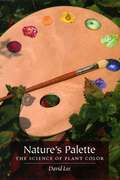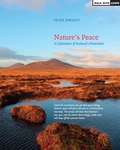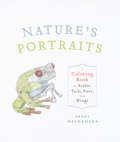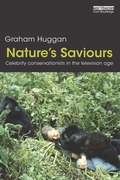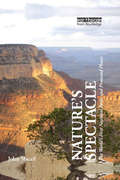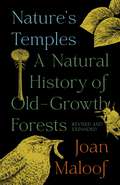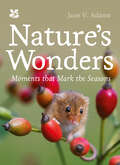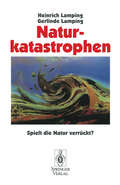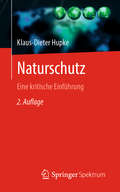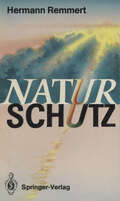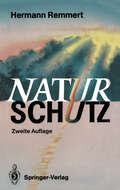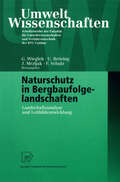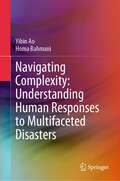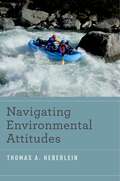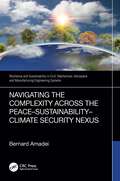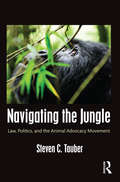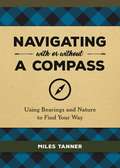- Table View
- List View
Nature's Palette: The Science of Plant Color
by David LeeThough he didn’t realize it at the time, David Lee began this book twenty-five years ago as he was hiking in the mountains outside Kuala Lumpur. Surrounded by the wonders of the jungle, Lee found his attention drawn to one plant in particular, a species of fern whose electric blue leaves shimmered amidst the surrounding green. The evolutionary wonder of the fern’s extravagant beauty filled Lee with awe—and set him on a career-long journey to understand everything about plant colors. Nature’s Palette is the fully ripened fruit of that journey—a highly illustrated, immensely entertaining exploration of the science of plant color. Beginning with potent reminders of how deeply interwoven plant colors are with human life and culture—from the shifting hues that told early humans when fruits and vegetables were edible to the indigo dyes that signified royalty for later generations—Lee moves easily through details of pigments, the evolution of color perception, the nature of light, and dozens of other topics. Through a narrative peppered with anecdotes of a life spent pursuing botanical knowledge around the world, he reveals the profound ways that efforts to understand and exploit plant color have influenced every sphere of human life, from organic chemistry to Renaissance painting to the highly lucrative orchid trade. Lavishly illustrated and packed with remarkable details sure to delight gardeners and naturalists alike, Nature’s Palette will enchant anyone who’s ever wondered about red roses and blue violets—or green thumbs.
Nature's Palette: The Science of Plant Color (Studies In Communication, Media, And Public Opinion Ser.)
by David LeeThough he didn’t realize it at the time, David Lee began this book twenty-five years ago as he was hiking in the mountains outside Kuala Lumpur. Surrounded by the wonders of the jungle, Lee found his attention drawn to one plant in particular, a species of fern whose electric blue leaves shimmered amidst the surrounding green. The evolutionary wonder of the fern’s extravagant beauty filled Lee with awe—and set him on a career-long journey to understand everything about plant colors. Nature’s Palette is the fully ripened fruit of that journey—a highly illustrated, immensely entertaining exploration of the science of plant color. Beginning with potent reminders of how deeply interwoven plant colors are with human life and culture—from the shifting hues that told early humans when fruits and vegetables were edible to the indigo dyes that signified royalty for later generations—Lee moves easily through details of pigments, the evolution of color perception, the nature of light, and dozens of other topics. Through a narrative peppered with anecdotes of a life spent pursuing botanical knowledge around the world, he reveals the profound ways that efforts to understand and exploit plant color have influenced every sphere of human life, from organic chemistry to Renaissance painting to the highly lucrative orchid trade. Lavishly illustrated and packed with remarkable details sure to delight gardeners and naturalists alike, Nature’s Palette will enchant anyone who’s ever wondered about red roses and blue violets—or green thumbs.
Nature's Peace: A Celebration of Scotland's Watershed (Ribbon of Wildness #3)
by Peter WrightIn 2005 Peter Wright walked the 1,200 km length of the Watershed in 64 days. Walking along the very spine of Scotland he was struck by the magnificence and diversity of the landscapes which his original and little publicised route exposed him to. Nature's Peace celebrates these landscapes as never before through stunning photographs, taking the reader on an imaginary journey from the English border in the south to the Shetland Isles and Unst at the very northern tip of Britain. Wright brings his journey to life with vivid descriptions of the land's history and discussions about its future.
Nature's Portraits: A Coloring Book of Scales, Tails, Furs, and Wings
by Peggy MacnamaraWhen it comes to color, nothing can surpass the vast palette found in nature, from a bright green leaf in a sun-dappled forest to the rich red feathers of a cardinal and the muted greens, ambers, and browns that make up the shell of a tortoise. Wildlife artist Peggy Macnamara has been recreating the natural world through her drawings and paintings for decades, and, with Nature’s Portraits, she invites the rest of the world to join her. Nature’s Portraits offers sixty of Macnamara’s detailed drawings that can be brought brilliantly to life with nothing more than a few colored pencils or crayons and a sense of wonder about the world around us. Many of the drawings depict animals as they might appear in their natural habitats—like a tree frog, a dashing, playful fox, a snowy owl poised for flight, a sauntering jaguar, and a watchful herd of giraffe. These wild furry and feathered friends are joined by animals found in museums, including Sue, the Field Museum’s resident Tyrannosaurus rex. Each illustration is captioned with a brief scientific description of the species pictured. Combining inspiration from natural history with a calming, creative activity, Nature’s Portraits encourages us to take a closer look at what we miss when we don’t take the time to stop and look with deep appreciation at the bounty of the natural world around us.
Nature's Saviours: Celebrity Conservationists in the Television Age
by Graham HugganToday's celebrity conservationists, many of whom made their reputations through television and other visual media, play a major role in drawing public attention to an increasingly threatened world. This book, one of the first to address this contribution, focuses on five key figures: the English naturalist David Attenborough, the French marine adventurer Jacques-Yves Cousteau, the American primatologist Dian Fossey, the Canadian scientist-broadcaster-activist David Suzuki, and the Australian 'crocodile hunter' Steve Irwin. Some of the issues the author addresses include: What is the changing relationship between western conservation and celebrity? How has the spread of television helped shape and mediate this relationship? To what extent can celebrity conservation be seen as part of a global system in which conservation, like celebrity, is big business? The book critically examines the heroic status accorded to the five figures mentioned above, taking in the various discourses – around nature, science, nation, gender – through which they and their work have been presented to us. In doing so, it fills in the cultural, historical and ideological background behind contemporary celebrity conservationism as a popular expression of a chronically endangered world.
Nature's Saviours: Celebrity Conservationists in the Television Age
by Graham HugganToday's celebrity conservationists, many of whom made their reputations through television and other visual media, play a major role in drawing public attention to an increasingly threatened world. This book, one of the first to address this contribution, focuses on five key figures: the English naturalist David Attenborough, the French marine adventurer Jacques-Yves Cousteau, the American primatologist Dian Fossey, the Canadian scientist-broadcaster-activist David Suzuki, and the Australian 'crocodile hunter' Steve Irwin. Some of the issues the author addresses include: What is the changing relationship between western conservation and celebrity? How has the spread of television helped shape and mediate this relationship? To what extent can celebrity conservation be seen as part of a global system in which conservation, like celebrity, is big business? The book critically examines the heroic status accorded to the five figures mentioned above, taking in the various discourses – around nature, science, nation, gender – through which they and their work have been presented to us. In doing so, it fills in the cultural, historical and ideological background behind contemporary celebrity conservationism as a popular expression of a chronically endangered world.
Nature's Spectacle: The World's First National Parks and Protected Places
by John SheailNational parks have always been an emotive and iconic symbol, ever since the first parks of the modern era were created in the mid-nineteenth century. This book, based on original research, delves deeply into their character and significance, and the larger context in which they developed. The book celebrates the deserved attractiveness of the parks as wilderness or 'spectacle' to millions of visitors, but also emphasises how there was nothing inevitable, self-sustaining or without cost in their magnificence and accessibility. Those early parks were a powerful unifying force as national 'playgrounds', especially as motor transport democratised their use. However they also provoked bitter conflict in their dispossession of local communities and perhaps deliberate segregation of people from scenery and wildlife. That first century of national parks, which concluded with the significant break of the Second World War and the subsequent development of more international approaches to conservation, left an uncertain legacy. It was a fragile foundation from which to build what became an integral part of today's conservation movement.
Nature's Spectacle: The World's First National Parks and Protected Places
by John SheailNational parks have always been an emotive and iconic symbol, ever since the first parks of the modern era were created in the mid-nineteenth century. This book, based on original research, delves deeply into their character and significance, and the larger context in which they developed. The book celebrates the deserved attractiveness of the parks as wilderness or 'spectacle' to millions of visitors, but also emphasises how there was nothing inevitable, self-sustaining or without cost in their magnificence and accessibility. Those early parks were a powerful unifying force as national 'playgrounds', especially as motor transport democratised their use. However they also provoked bitter conflict in their dispossession of local communities and perhaps deliberate segregation of people from scenery and wildlife. That first century of national parks, which concluded with the significant break of the Second World War and the subsequent development of more international approaches to conservation, left an uncertain legacy. It was a fragile foundation from which to build what became an integral part of today's conservation movement.
Nature's Temples: A Natural History of Old-Growth Forests Revised and Expanded
by Joan MaloofAn impassioned case for the importance of ancient forests and their preservationStanding in an old-growth forest, you can instinctively sense the ways it is different from forests shaped by humans. These ancient, undisturbed ecosystems are increasingly rare and largely misunderstood. Nature’s Temples explores the science and alchemy of old-growth forests and makes a compelling case for their protection.Many foresters are proponents of forest management, while ecologists and conservation biologists believe that the healthiest forests are those we leave alone. Joan Maloof brings together the scientific data we have about old-growth forests, drawing on diverse fields of study to explain the ecological differences among forests of various ages. She describes the life forms and relationships that make old-growth forests unique—from salamanders and micro-snails to plants that communicate through fungi—and reveals why human attempts to manage forests can never replicate nature’s sublime handiwork. This revised and expanded edition also sheds new light on the special role forests play in removing carbon from the atmosphere and shares what we know about the interplay between wildfires and ancient forests.With drawings by Andrew Joslin that illustrate scientific concepts and capture the remarkable beauty of ancient trees, Nature’s Temples invites you to discover the power of these fragile realms that are so inextricably connected to our planet, our fellow species, and our spirits.
Nature’s Wonders: Moments that mark the seasons (National Trust)
by Jane V. Adams National Trust BooksBritain’s nature year, from the first flower to the last leaf
Naturkatastrophen: Spielt die Natur verrückt?
by Heinrich Lamping Gerlinde LampingNaturkatastrophen vernichten jedes Jahr Tausende von Menschenleben - spielt die Natur verrückt? Die Autoren zeigen, wie aus den Launen der Natur Katastrophen werden und welchen Anteil der Mensch daran hat.
Naturschutz: Ein kritischer Ansatz
by Klaus-Dieter HupkeIn Naturschutzgebieten geschieht vieles, das auf den ersten Blick widersprüchlich ist. So werden beim Pflegeeinsatz Blumenwiesen abgemäht, wo doch alle dort wachsenden Pflanzen unter Naturschutz stehen. An anderer Stelle werden im Flachmoor geschützte Schilfbestände abgebrannt oder in einem Dünenschutzgebiet die oberste Bodenschicht mit Planierraupen abgetragen. Wiederum andere Flächen sollen völlig unberührt von menschlichen Eingriffen bleiben. Der Autor Klaus-Dieter Hupke zeigt die verschiedenen Strategien von Naturschutz auf. Er zeigt auch, dass Naturschutz zumeist gerade das nicht ist, was der Begriff im Kern aussagt: „Schutz der Natur“. In Mitteleuropa handelt es sich bei Naturschutzgebieten im Gegenteil überwiegend um die Relikte alter Agrar- und damit Kulturlandschaften. Oftmals stehen auch ästhetische Aspekte eines Landschaftsausschnitts bei der Ausweisung als Naturdenkmal oder Naturschutzgebiet im Vordergrund. Darüber hinaus läuft der Naturschutz Gefahr, zur Ersatzhandlung und zum Alibi für eine in Mitteleuropa wie global immer noch wachsende Zerstörung traditioneller und naturnaher Landschaftssysteme zu werden.
Naturschutz: Eine kritische Einführung
by Klaus-Dieter HupkeIn Naturschutzgebieten geschieht vieles, das auf den ersten Blick widersprüchlich ist. So werden beim Pflegeeinsatz Blumenwiesen abgemäht, wo doch alle dort wachsenden Pflanzen unter Naturschutz stehen. An anderer Stelle werden im Flachmoor geschützte Schilfbestände abgebrannt oder in einem Dünenschutzgebiet die oberste Bodenschicht mit Planierraupen abgetragen. Wiederum andere Flächen sollen völlig unberührt von menschlichen Eingriffen bleiben. Der Autor Klaus-Dieter Hupke zeigt die verschiedenen Strategien von Naturschutz auf. Er zeigt auch, dass Naturschutz zumeist gerade das nicht ist, was der Begriff im Kern aussagt: „Schutz der Natur“. In Mitteleuropa handelt es sich bei Naturschutzgebieten im Gegenteil überwiegend um die Relikte alter Agrar- und damit Kulturlandschaften. Oftmals stehen auch ästhetische Aspekte eines Landschaftsausschnitts bei der Ausweisung als Naturdenkmal oder Naturschutzgebiet im Vordergrund. Darüber hinaus läuft der Naturschutz Gefahr, zur Ersatzhandlung und zum Alibi für eine in Mitteleuropa wie global immer noch wachsende Zerstörung traditioneller und naturnaher Landschaftssysteme zu werden.Die aktualisierte zweite Auflage bezieht die Folgen des Klimawandels für den Naturschutz nun explizit ein und hat auch an einigen Stellen für die entsprechenden Leser einen stärkeren Bezug auf Österreich sowie auf den zentralalpinen Raum eingearbeitet.
Naturschutz: Ein Lesebuch nicht nur für Planer, Politiker und Polizisten, Publizisten und Juristen
by Hermann RemmertProfessor Hermann Remmert, führender Ökologie-Experte und Autor zahlreicher wissenschaftlicher Publikationen, gibt hier eine gut lesbare und auch für den Laien verständliche Einführung in die viel-diskutierte Thematik: Naturschutz. Ausgehend von uns überlieferten ökologischen Katastrophen aus früherer Zeit (der älteste Bericht über die Verkarstung des Gebirges durch menschlichen Einfluß stammt von Plato, circa 400 v.Chr.) und deren Bewältigung führt der Autor in alle Aspekte des modernen Naturschutzes ein. Die Gliederung des Buches folgt den Fragestellungen: - Was ist Naturschutz? - Warum brauchen wir ihn, für wen und für was? - Wer hat zu schützen, und was? - Wie hat das zu geschehen (Artenschutz, Biotopschutz, Schutz der ökologischen Prozesse)? - Wo muß der Naturschutz einsetzen? - Wie groß müssen Naturschutzgebiete sein? - Was "kosten" Naturschutzgebiete? - Wie werden die Konzepte des Naturschutzes in der Lehre behandelt, weitergegeben und letzlich realisiert? Diese Thematik wird ergänzt durch die Erörterung des rechtlichen Rahmens, innerhalb dessen Naturschutz verankert werden kann und sollte. In einer lebendigen Sprache und anhand von plastischen Beispielen stellt H. Remmert die heutige Situation des Naturschutzes speziell für diejenigen dar, die zunächst dem Naturschutz beruflich und gedanklich fernstehen, aber im Zuge unserer Umweltkrise nun direkt - und sei es nur im Urlaub - mit (mangelndem) Naturschutz konfrontiert werden.
Naturschutz: Ein Lesebuch nicht nur für Planer, Politiker, Polizisten, Publizisten und Juristen
by Hermann RemmertProfessor Hermann Remmert, führender Ökologie-Experte und Autor zahlreicher wissenschaftlicher Publikationen, gibt hier eine gut lesbare und auch für den Laien verständliche Einführung in die viel-diskutierte Thematik: Naturschutz. Die Gliederung des Buches folgt den Fragestellungen: - Was ist Naturschutz? - Warum brauchen wir ihn, für wen und für was? - Wer hat zu schützen, und was? - Wie hat das zu geschehen (Artenschutz, Biotopschutz, Schutz der ökologischen Prozesse)? - Wo muß der Naturschutz einsetzen? - Wie groß müssen Naturschutzgebiete sein? - Was "kosten" Naturschutzgebiete? - Wie werden die Konzepte des Naturschutzes in der Lehre behandelt, weitergegeben und letztlich realisiert? Diese Thematik wird ergänzt durch die Erörterung des rechtlichen Rahmens, innerhalb dessen Naturschutz verankert werden kann und sollte. In einer lebendigen Sprache und anhand von plastischen Beispielen stellt H. Remmert die heutige Situation des Naturschutzes speziell für diejenigen dar, die zunächst dem Naturschutz beruflich und gedanklich fernstehen, aber im Zuge unserer Umweltkrise nun direkt - und sei es nur im Urlaub - mit (mangelndem) Naturschutz konfrontiert werden.
Naturschutz in Bergbaufolgelandschaften: Landschaftsanalyse und Leitbildentwicklung (UmweltWissenschaften)
by Gerhard Wiegleb Udo Bröring Jadranka Mrzljak Friederike SchulzNaturschutzrecht im Klimawandel: Juristische Konzepte für naturschutzfachliche Anpassungsstrategien (Schriftenreihe Natur und Recht #17)
by Jochen Schumacher Anke Schumacher Ellen Krüsemann Stephanie Rebsch Regine Becker Frank Niederstadt Werner Konold Peter WattendorfDer Klimawandel führt zu einer weitreichenden Veränderung der Umwelt. Sichtbare Ereignisse sind z.B. die gehäuften Extremwetterereignisse und das damit verbundene Hochwasserrisiko oder auch Dürreperioden. Auch die Biologische Vielfalt ist von dem Klimawandel nachhaltig betroffen. Um die Biodiverstitätsverluste abzumildern sind naturschutzfachliche Anpassungsstrategien notwendig, die z.B. auf eine Durchlässigkeit der Landschaft und eine (Wieder-)Vernetzung von Schutzgebieten abzielen.Um die Umsetzung dieser Anpassungsstrategien zu ermöglichen, muss hierfür auch ein geeigneter rechtlicher Rahmen gegeben sein.Das Werk analysiert, inwieweit die internationalen, europäischen und nationalen naturschutzrechtlichen Regelungen die Umsetzung der naturschutzfachlichen Anpassungsstrategien an den Klimawandel und für die Nutzung von Synergieeffekten mit Klimaschutzmaßnahmen ermöglichen oder fordern.
Navigating Complexity: Understanding Human Responses to Multifaceted Disasters
by Yibin Ao Homa BahmaniThis thought-provoking book unravels the intricate interplay between human behavior and disasters, weaving a rich narrative that transcends traditional boundaries. Embark on a captivating exploration of human responses to multifaceted disasters with this book. Unveiling the human psyche and the intricate web of emotions that intertwine with disaster events, this book offers a profound understanding of human responses to multifaceted disasters.Written with precision and meticulous research, this book captivates scholars, practitioners, and policymakers alike. Its multidimensional perspectives offer valuable insights for disaster management, urban planning, sociology, and public health, transcending disciplinary boundaries.
Navigating Environmental Attitudes
by Thomas A. HeberleinThe environment, and how humans affect it, is more of a concern now than ever. We are constantly told that halting climate change requires raising awareness, changing attitudes, and finally altering behaviors among the general public-and fast. New information, attitudes, and actions, it is conventionally assumed, will necessarily follow one from the other. But this approach ignores much of what is known about attitudes in general and environmental attitudes specifically-there is a huge gap between what we say and what we do. Solving environmental problems requires a scientific understanding of public attitudes. Like rocks in a swollen river, attitudes often lie beneath the surface-hard to see, and even harder to move or change. In Navigating Environmental Attitudes, Thomas Heberlein helps us read the water and negotiate its hidden obstacles, explaining what attitudes are, how they change and influence behavior. Rather than necessarily trying to change public attitudes, we need to design solutions and policies with them in mind. He illustrates these points by tracing the attitudes of the well-known environmentalist Aldo Leopold, while tying social psychology to real-world behaviors throughout the book. Bringing together theory and practice, Navigating Environmental Attitudes provides a realistic understanding of why and how attitudes matter when it comes to environmental problems; and how, by balancing natural with social science, we can step back from false assumptions and unproductive, frustrating programs to work toward fostering successful, effective environmental action. "With lively prose, inviting stories, and solid science, Heberlein pilots us deftly through the previously uncharted waters of environmental attitudes. It's a voyage anyone interested in environmental issues needs to take." -- Robert B. Cialdini, author of Influence: Science and Practice "Navigating Environmental Attitudes is a terrific book. Heberlein's authentic voice and the book's organization around stories keeps readers hooked. Wildlife biologists, natural resource managers, conservation biologists - and anyone else trying to solve environmental problems - will learn a lot about attitudes, behaviors, and norms; and the fallacy of the Cognitive Fix." -- Stephen Russell Carpenter, Stephen Alfred Forbes Professor of Zoology, University of Wisconsin-Madison "People who have spent their lives dealing with environmental issues from a broad range of perspectives consistently abide by erroneous assumption that all we need to do to solve environmental problems is to educate the public. I consider it to be the most dangerous of all assumptions in environmental management. In Navigating Environmental Attitudes, Tom Heberlein brings together expertise in social and biophysical sciences to do an important kind of 'science education'-educating eminent scientists about the realities of their interactions with the broader public." --the late Bill Freudenburg, Dehlsen Professor of Environment and Society, University of California, Santa Barbara
Navigating Environmental Attitudes
by Thomas A. HeberleinThe environment, and how humans affect it, is more of a concern now than ever. We are constantly told that halting climate change requires raising awareness, changing attitudes, and finally altering behaviors among the general public-and fast. New information, attitudes, and actions, it is conventionally assumed, will necessarily follow one from the other. But this approach ignores much of what is known about attitudes in general and environmental attitudes specifically-there is a huge gap between what we say and what we do. Solving environmental problems requires a scientific understanding of public attitudes. Like rocks in a swollen river, attitudes often lie beneath the surface-hard to see, and even harder to move or change. In Navigating Environmental Attitudes, Thomas Heberlein helps us read the water and negotiate its hidden obstacles, explaining what attitudes are, how they change and influence behavior. Rather than necessarily trying to change public attitudes, we need to design solutions and policies with them in mind. He illustrates these points by tracing the attitudes of the well-known environmentalist Aldo Leopold, while tying social psychology to real-world behaviors throughout the book. Bringing together theory and practice, Navigating Environmental Attitudes provides a realistic understanding of why and how attitudes matter when it comes to environmental problems; and how, by balancing natural with social science, we can step back from false assumptions and unproductive, frustrating programs to work toward fostering successful, effective environmental action. "With lively prose, inviting stories, and solid science, Heberlein pilots us deftly through the previously uncharted waters of environmental attitudes. It's a voyage anyone interested in environmental issues needs to take." -- Robert B. Cialdini, author of Influence: Science and Practice "Navigating Environmental Attitudes is a terrific book. Heberlein's authentic voice and the book's organization around stories keeps readers hooked. Wildlife biologists, natural resource managers, conservation biologists - and anyone else trying to solve environmental problems - will learn a lot about attitudes, behaviors, and norms; and the fallacy of the Cognitive Fix." -- Stephen Russell Carpenter, Stephen Alfred Forbes Professor of Zoology, University of Wisconsin-Madison "People who have spent their lives dealing with environmental issues from a broad range of perspectives consistently abide by erroneous assumption that all we need to do to solve environmental problems is to educate the public. I consider it to be the most dangerous of all assumptions in environmental management. In Navigating Environmental Attitudes, Tom Heberlein brings together expertise in social and biophysical sciences to do an important kind of 'science education'-educating eminent scientists about the realities of their interactions with the broader public." --the late Bill Freudenburg, Dehlsen Professor of Environment and Society, University of California, Santa Barbara
Navigating the Complexity Across the Peace–Sustainability–Climate Security Nexus (Resilience and Sustainability in Civil, Mechanical, Aerospace and Manufacturing Engineering Systems)
by Bernard AmadeiPromoting peace and sustainability in human development while accounting for the risks associated with the impact of climate change on society has become more imperative than ever when addressing humanity's challenges of the twenty-first century. There is enough evidence that peace, sustainability, and climate security are entangled with multiple complex interactions and cannot be dealt with in isolation and independently from the environment and the numerous systems with which they interact. Yet, the intersection of peace, sustainability, and climate security or their opposites (i.e., conflict, unsustainability, and climate vulnerability) is rarely articulated with a systemic mindset. A multi-solving nexus approach is more appropriate to capture the complexity and uncertainty of how the three sectors of peace, sustainability, and climate security play a role in community development, the nature of their causal chains, and the feedback on how community development affects the three sectors. Navigating the Complexity Across the Peace–Sustainability–Climate Security Nexus explores the value proposition of using a systems approach, methodology, and tools to comprehend and model that dynamic. Features of the book: Explores the interaction between the different components of peace and the relationship between peace, sustainability, and climate security using semi-qualitative and quantitative tools; Explains how climate adaptation and mitigation are related to peace or conflict; Presents generic system dynamics modeling that can be used in different contexts.
Navigating the Complexity Across the Peace–Sustainability–Climate Security Nexus (Resilience and Sustainability in Civil, Mechanical, Aerospace and Manufacturing Engineering Systems)
by Bernard AmadeiPromoting peace and sustainability in human development while accounting for the risks associated with the impact of climate change on society has become more imperative than ever when addressing humanity's challenges of the twenty-first century. There is enough evidence that peace, sustainability, and climate security are entangled with multiple complex interactions and cannot be dealt with in isolation and independently from the environment and the numerous systems with which they interact. Yet, the intersection of peace, sustainability, and climate security or their opposites (i.e., conflict, unsustainability, and climate vulnerability) is rarely articulated with a systemic mindset. A multi-solving nexus approach is more appropriate to capture the complexity and uncertainty of how the three sectors of peace, sustainability, and climate security play a role in community development, the nature of their causal chains, and the feedback on how community development affects the three sectors. Navigating the Complexity Across the Peace–Sustainability–Climate Security Nexus explores the value proposition of using a systems approach, methodology, and tools to comprehend and model that dynamic. Features of the book: Explores the interaction between the different components of peace and the relationship between peace, sustainability, and climate security using semi-qualitative and quantitative tools; Explains how climate adaptation and mitigation are related to peace or conflict; Presents generic system dynamics modeling that can be used in different contexts.
Navigating the Jungle: Law, Politics, and the Animal Advocacy Movement
by Steven C. TauberFor much of our history, legal scholars focused predominantly on the law’s implications for human beings, while ignoring how the law influences animal welfare. Since the 1970s, however, there has been a steep increase in animal advocates’ use of the courts. Animal law has blossomed into a vibrant academic discipline, with a rich literature that examines how the law affects animal welfare and the ability of humans to advocate on behalf of nonhuman animals. But most animal law literature tends to be doctrinally-based or normative. There has been little empirical study of the outcomes of animal law cases and there has been very little attention paid to the political influences of these outcomes. This book fills the gap in animal law literature. This is the first empirically-based analysis of animal law that emphasizes the political forces that shape animal law outcomes.
Navigating the Jungle: Law, Politics, and the Animal Advocacy Movement
by Steven C. TauberFor much of our history, legal scholars focused predominantly on the law’s implications for human beings, while ignoring how the law influences animal welfare. Since the 1970s, however, there has been a steep increase in animal advocates’ use of the courts. Animal law has blossomed into a vibrant academic discipline, with a rich literature that examines how the law affects animal welfare and the ability of humans to advocate on behalf of nonhuman animals. But most animal law literature tends to be doctrinally-based or normative. There has been little empirical study of the outcomes of animal law cases and there has been very little attention paid to the political influences of these outcomes. This book fills the gap in animal law literature. This is the first empirically-based analysis of animal law that emphasizes the political forces that shape animal law outcomes.
Navigating With or Without a Compass: Using Bearings and Nature to Find Your Way
by Miles TannerNever be lost again! This concise and handy guide will help you get your bearings and find your way out of the wilderness no matter your equipment. Finding your campsite, a spectacular view, or your way home can be difficult, especially when your phone or GPS malfunctions. But knowing how to use a magnetized compass, paper map, and the positions of the sun, moon, stars, and other practical aids in pathfinding will help outdoorsman find their way in almost any kind of terrain. Navigating With or Without a Compass will teach you the basics of using that essential tool, such as the difference between true north and magnetic north based on where you are and using compass bearings from a map and in the field to determine location. However if you find yourself without a compass, this handy guide will also give you natural signs and guideposts for pathfinding, such as the way the wind blows, trees grow, or flowers bloom. Also covered will be determining direction through reading the Sun and the shadows it forms, the position and stages of the Moon, and familiarizing oneself with the principal constellations to guide you and determine the time at night. Perfect for the skilled woodsman or just a walk in the woods, Navigating With or Without a Compass is filled with tips and essential knowledge indispensible for hikers, campers, scouts and nature lovers.
